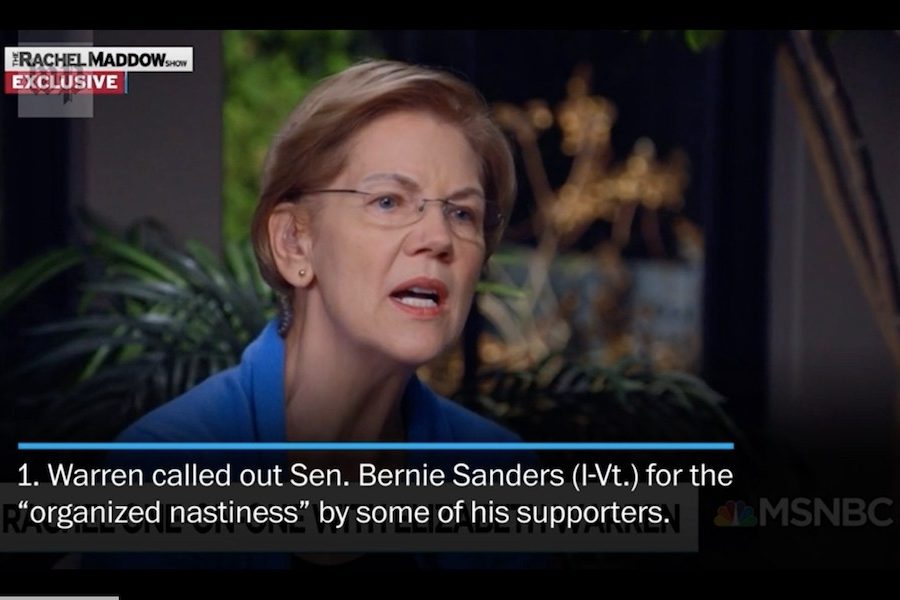To Win Elections, Should the Left Be Nicer on the Internet?
There are signs that antagonistic Bernie supporters may have discouraged coalition-building with winnable Warren voters.
Zeeshan Aleem

This is part of a roundtable on lessons from the 2020 primaries. Read Maximillian Alvarez’s response here.
A modest proposal for the Left as it sorts through the ashes of the Democratic primary and considers how to improve its next major electoral run: Be nicer on the Internet.
In some quarters of the Left, this sentiment is considered a distraction from more substantive issues of campaigning. But the lessons of 2020 suggest that the toxic aspects of the online culture of the Left were a salient part of the political climate, and may have dampened Sanders’s ability to coalition-build with progressives outside his core base — most notably, Warren supporters — who could’ve helped defeat Joe Biden at the polls. A renewed focus on civility in the electoral sphere could expand the mass appeal of leftist thinking, and it could also have salutary effects within the Left by reminding itself what it means to foster a truly democratic culture.
As I’ve written elsewhere, I’ve never bought into the mainstream conception of the Bernie Bro archetype, and take issue with its effacing of women and people of color within the Left. But there is no doubt that there is a real cohort of hardcore Sanders supporters — likely a small minority of his base, but extremely prominent in online debate — who viewed being adversarial toward Sanders’s rivals and critics online as a political strategy. They disseminated memes of Elizabeth Warren as a snake and Pete Buttigieg as a rat, dogpiled Sanders critics, doxed reporters, rendered a party officials’ phone unusable, swarmed the business ratings of a critic, and propagated death wishes, profanity and all kinds of rancor online. The most high-profile instance of this belligerent behavior transpired when people hurled bigoted insults and death threats at leaders of Nevada’s Culinary Union using social media, email, and phone calls after they published a flier critical of Sanders. While it is impossible to verify the identity and political agenda of every perpetrator in that incident, some self-identified as Sanders supporters, and given other behavior during the campaign season, it is plausible that this was true.
There is reason to think that this behavior may have influenced broader perception of Sanders as a candidate. Exit polling indicates that 10 to 20 percent of early primary state voters used Twitter regularly for political news, and that Sanders supporters generally constituted only a narrow plurality of this set, meaning plenty of Dems outside of BernieWorld were likely witnessing some online skirmishes. The fact that mainstream journalists (many of whom already appeared keen on undermining Sanders’s campaign) were relentlessly targeted by hardcore Sandernista ire likely contributed to the issue being repeatedly raised in televised town halls, debates and long, reported pieces, ensuring that even those who didn’t witness it heard about it happening to it someone else. After dropping out of the race, Warren, sat down with MSNBC’s Rachel Maddow and spoke for seven minutes about online harassment among Sanders supporters in an interview which was expected to be a potential endorsement platform.
The pervasiveness of this idea couldn’t have done Sanders any favors in trying to win over Warren supporters early on in the primary season — when a clear plurality of them saw Sanders as their second choice — and it may have hurt his ability to secure them as her star fell. We don’t have definitive evidence demonstrating a causal link, but many Warren supporters online did complain about ill-tempered Sanders supporters and linked it to an aversion to backing him; and The Daily Beast’s politics editor Sam Stein reported that the culture surrounding Sanders supporters was a turn-off among Warren supporters town halls he attended. We also know that high-profile candidate signaling was hugely influential in this crowded race—Rep. Jim Clyburn’s backing helped Biden dominate in South Carolina, and Buttigieg and Klobuchar seamlessly funneled their supporters to the former veep before Super Tuesday — and so Warren’s repeated complaints about Sanders’s online following, coupled with her non-endorsement, was likely a meaningful hit against him.
Vilifying and alienating Warren and her supporters should be understood as an unforced error. It was necessary to highlight the differences between Sanders and Warren in the run-up to the primaries, but it was possible to draw distinctions without burning the bridges that were needed for progressive consolidation later down the line.
Some on the Left argued that Warren, whose base skewed more college-educated and affluent than Sanders’s base, had different class interests than the working class voters Sanders was most focused on enticing to the voting booth, and thus spurning Warren voters was of no consequence.
But the reality is many Warren supporters were open to Sanders’ policy agenda. We know this because Sanders and Warren overwhelmingly agreed on key domestic policy objectives; because Warren supporters included a substantial bloc of former Sanders supporters; and because throughout much of 2019 she was the top choice among very liberal Democrats. This shouldn’t be a surprise — college education correlates strongly with support for progressive policies, including aggressive redistributionist policies. In other words, there is no reason to believe that Sanders’s platform would need to be compromised to appeal to the higher-income professionals that made up Warren’s electoral sweet spot, even if they weren’t the prime beneficiary of some of his policy goals.
And the case for being open-minded toward Warren voters is strengthened further by the fact that Sanders proved unable to turn out first-time and disaffected working class voters en masse as he had hoped to. Why should the Left turn away a potential voting bloc that comes at no cost to its policy platform when it is still in the process of building an electorally meaningful left-wing working class base — a process that could take generations, given the weakness of labor unions and the immense hurdles to voting while poor?
Some on the Left say that the complaints about aggressive Sanders behavior was overblown, since every candidate had its share of abusive supporters, and it may be the case that perception of Sanders’ more abrasive crowd really is in part a function of the fact that he has a much larger online following. But this fails as a counterargument for a couple of reasons. First, it’s no secret that some influential groups in Leftie discourse online actively advocate for being adversarial as a conscious political tactic—and so it’s not just fringe behavior of random individuals. But more importantly, saying “but the other side does it, too!” isn’t an appropriate stance for a political movement that is small and growing, and whose premise for entry into mainstream electoral politics is that it is elevating standards for justice and fairness. Simply put, the Left should hold itself to higher standards than the Democratic establishment in rhetoric, just the way it does on policy. If there was a cost associated with trying to be a bit nicer, then a discussion about trade-offs would make sense. But there are no costs — and there are obvious potential upsides.
This is not a call for the Left to be docile. Rather, it’s a case for leftists online to see themselves as surrogates for their cause, and to develop a discerning and strategic eye when it comes to being antagonistic. Rage is a real political tool, but outright vitriol should be reserved for people and organizations who deserve it most; organizing a street fight against neo-Nazis or mobilizing a strike against a brutal boss requires a different set of energies and affects than putting together the numbers for winning a national election. The US’s two-party system necessarily entails assembling coalitions, and both 2016 and 2020 show that the math is punishing to those who ignore that reality.
Do we know if online behavior played a decisive role for a substantial chunk of Warren supporters? It’s unclear. Is it possible that even without the factor of obnoxious Bernie supporters, that many of Warren’s progressive supporters would have declined to pivot to Sanders? Certainly. It is, after all, possible that her identities as a wonk or a firebrand feminist were essential to sealing the deal with some of her followers. But we know for a fact that many were intrigued by or fully behind Sanders’s policy agenda, and that those people were not systematically courted as potential allies.
On the surface, it might seem petty for a progressive to decline to back Sanders and fall in line with Biden because someone was a dick to them online, or perhaps even in person. I personally don’t think it’s nearly good enough of a reason to side with Biden’s status quo restoration agenda. But any movement that blames voters for not voting for them is never going to be a serious one. And so it’s worth thinking more deeply about why some people are so bothered by rudeness and bullying online, and trying to understand what it signals to people on the outside. It seems likely that people view it as a signal that a movement is not inclusive, and inhospitable to internal debate.
Learning to value persuasion over pillorying when thinking about winning over voters is not just PR — it’s true to the spirit of a truly democratic Left. Creating a political climate in which people within or adjacent to the movement can reason with each other rather than shout each other down is a precondition for the robust flow of ideas and the social inclusiveness needed to make the Left a real home for those who have been pushed to the margins.
Read Maximillian Alvarez’s response to this piece: Class Traitors, Welcome to the Revolution
Read other perspectives on lessons for the Left from the 2020 primaries:
Phillip Agnew: Black Voters Are Ready. Are We?
Astra Taylor: Bernie Sanders’ Exit Is an Indictment of Our Broken System
Hamilton Nolan: Bernie Lost Because America Doesn’t Have a Strong Labor Movement
David Sirota: The Democratic Party’s Tyranny of Decorum Helped Sink Bernie





